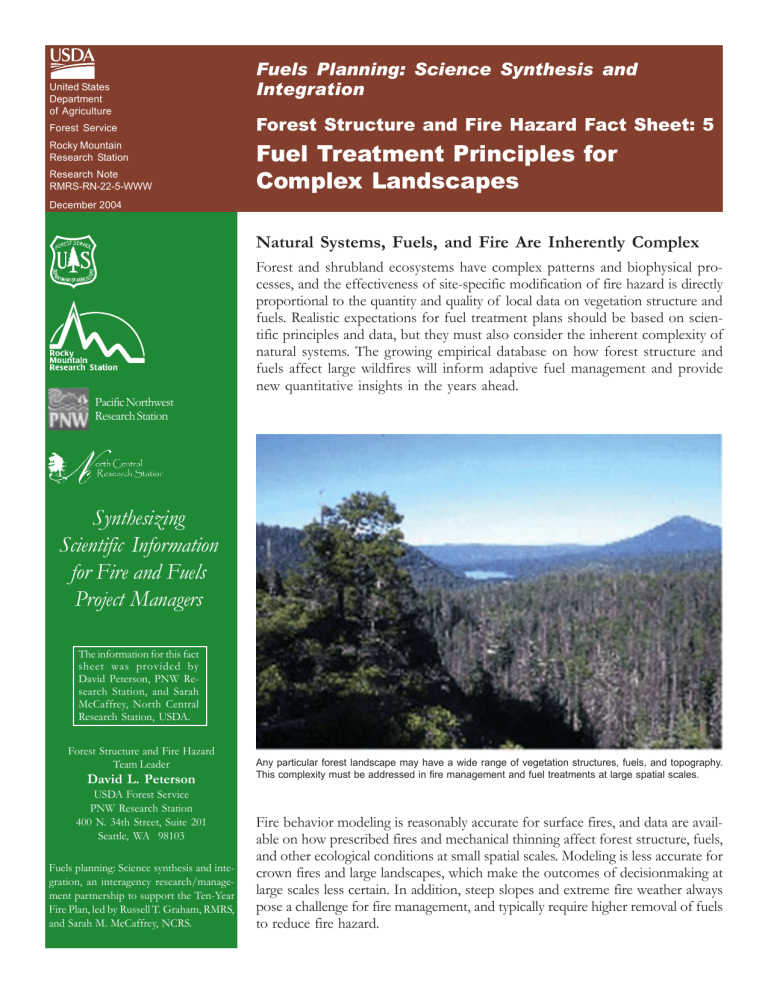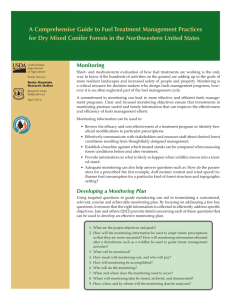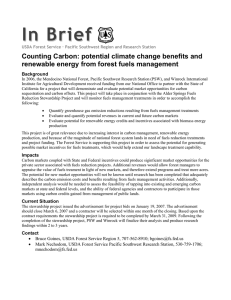Fuel Treatment Principles for Complex Landscapes Fuels Planning: Science Synthesis and Integration

United States
Department of Agriculture
Forest Service
Rocky Mountain
Research Station
Research Note
RMRS-RN-22-5-WWW
December 2004
Fuels Planning: Science Synthesis and
Integration
Forest Structure and Fire Hazard Fact Sheet: 5
Fuel Treatment Principles for
Complex Landscapes
Natural Systems, Fuels, and Fire Are Inherently Complex
Forest and shrubland ecosystems have complex patterns and biophysical processes, and the effectiveness of site-specific modification of fire hazard is directly proportional to the quantity and quality of local data on vegetation structure and fuels. Realistic expectations for fuel treatment plans should be based on scientific principles and data, but they must also consider the inherent complexity of natural systems. The growing empirical database on how forest structure and fuels affect large wildfires will inform adaptive fuel management and provide new quantitative insights in the years ahead.
Pacific Northwest
Research Station
Synthesizing
Scientific Information for Fire and Fuels
Project Managers
The information for this fact sheet was provided by
David Peterson, PNW Research Station, and Sarah
McCaffrey, North Central
Research Station, USDA.
Forest Structure and Fire Hazard
Team Leader
David L. Peterson
USDA Forest Service
PNW Research Station
400 N. 34th Street, Suite 201
Seattle, WA 98103
Fuels planning: Science synthesis and integration, an interagency research/management partnership to support the Ten-Year
Fire Plan, led by Russell T. Graham, RMRS, and Sarah M. McCaffrey, NCRS.
Any particular forest landscape may have a wide range of vegetation structures, fuels, and topography.
This complexity must be addressed in fire management and fuel treatments at large spatial scales.
Fire behavior modeling is reasonably accurate for surface fires, and data are available on how prescribed fires and mechanical thinning affect forest structure, fuels, and other ecological conditions at small spatial scales. Modeling is less accurate for crown fires and large landscapes, which make the outcomes of decisionmaking at large scales less certain. In addition, steep slopes and extreme fire weather always pose a challenge for fire management, and typically require higher removal of fuels to reduce fire hazard.
One challenge is “scaling up” our knowledge about smallscale phenomena to large, complex landscapes. Quantitative techniques for accomplishing this exist, but can be difficult to apply. We need the expertise of local resource managers to complement the quantitative output from modeling in order to make good judgments about potential fire hazard and fire behavior for a particular location. An interdisciplinary team of managers and researchers is an effective approach for integrating logistical, scientific, and regulatory issues relative to fuel treatments.
A Focus on Basic Principles
Appropriate types of thinning and surface fuel treatments are clearly useful in reducing surface and crown fire hazards under a wide range of fuels and topographic situations. Well-established scientific principles
(table 1) and simulation tools can be used to adjust fuel treatments to attain specific risk levels. For example, fire managers can reduce risk of future crown fires by planning for fuel and forest structures that achieve a specific fire hazard or predicted fire behavior outcome for extreme fire weather conditions (for example, the
97th percentile worst conditions). This provides greater resource protection and lower risk than basing fuel planning on moderate fire weather (for example, the 50th percentile worst conditions).
In the face of this complexity, focusing on basic scientific principles can facilitate decisionmaking and guide future data collection.
Table 1 —Fuel treatment principles a .
Principle
Reduce surface fuels
Increase canopy base height
Decrease crown density
Retain larger trees
Effect
Reduces potential flame length
Requires longer flame length to start torching
Makes tree-to-tree crown fire less likely
Increases proportion of trees with thicker bark, taller crowns
Advantage
Improves control, reduces torching
Reduces torching
Concerns
Need to keep surface disturbance relatively low
Opens understory, surface wind may increase
Reduces potential for Surface wind may increase, crown fire surface fuels may be drier
Increases tree survival Removing smaller trees is economically less profitable a Adapted from Agee, J. K. 2002. Fire behavior and fire-resilient forests. In: Fitzgerald, S. A., ed. Fire in Oregon’s forests: risks, effects, and treatment options. Portland, OR: Oregon Forest Resources Institute: 119–126.
Note: The relative emphasis on these four principles may vary from stand to stand and from watershed to watershed. However, they should all be considered in planning effective fuel treatments across complex landscapes.
Forest Structure and Fire Hazard Fact
Sheets
Look for other fact sheet topics from the Forest Structure and Fire
Hazard Team with information about fire hazard, visualization, silviculture, uncertainty, and larger scale treatments.
Fuels Planning: Synthesis and Integration
This fact sheet is one in a series being produced as part of a larger project supported by the USDA Forest Service to synthesize new knowledge and information relevant to fire and fuels management. Fact sheets address topics related to stand structure, environmental impacts, economics, and human responses to these factors. Information in the fact sheets is targeted for the dry forests of the Inland West, but is often applicable across broad regions of the country. For more information, please visit our Web site at: www.fs.fed.us/fire/tech_transfer/synthesis/synthesis_index
The Fuels Planning fact sheets are based on preliminary findings. Information from fact sheets will be synthesized in an upcoming publication.


